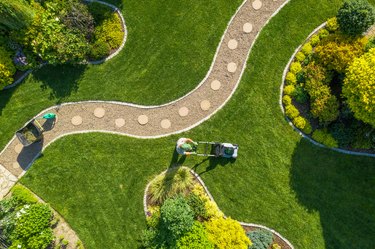
Fertilizer plays an important part in maintaining a lawn or garden. When soil lacks necessary nutrients, adding fertilizer provides them and encourages plant growth. Too much fertilizer or fertilizer that is applied incorrectly can have a negative effect, however, burning grass or other plants and even killing them in some cases. Because of that possibility, it is very important to apply strong lawn fertilizers, such as the granular Lesco 17-17-17 Professional Turf Fertilizer, correctly by following the 17-17-17 fertilizer rate printed on the product label.
Understanding the Numbers
Video of the Day
Before applying Lesco 17-17-17 Professional Turf Fertilizer, determine if it is actually the fertilizer that your lawn needs. The numbers in the fertilizer's name indicate the percentages of nitrogen, phosphorous and potassium in the fertilizer; the percentages are often referred to as the fertilizer's N-P-K value.
Video of the Day
Lesco 17-17-17 is a balanced fertilizer because it has equal percentages of all three elements, but those percentages are much higher than in some fertilizers. Therefore, Lesco 17-17-17 fertilizer uses are for more nutrient deficient soils and shouldn't be used if your lawn needs only minor fertilizing.
Testing the Soil
You can avoid overfertilizing your lawn by testing its soil in multiple locations to estimate the current nitrogen level in the area you want to fertilize. Soil test kits are available at many garden centers. Apply Lesco 17-17-17 Professional Turf Fertilizer only if the soil test shows that the lawn suffers from a nitrogen deficiency because a high nitrogen level in the soil will cause the fertilizer to burn the grass. Soil's nitrogen level is used as the key indicator of whether or not fertilizer is needed because nitrogen is the most likely fertilizer component to damage lawn grass.
Measuring the Area
Measuring the area that you intend to fertilize will help you figure out exactly how much fertilizer to apply. When you have the area's measurement, convert it to a percentage of 1,000 square feet by simply dividing the area's measurement by 1,000. The result probably will be a number that consists of a single digit followed by a few decimals. For example, an area of 1,250 square feet divided by 1,000 square feet equals 1.25 percent of 1,000 square feet.
17-17-17 Fertilizer Rate
Lesco 17-17-17 Professional Turf Fertilizer should be applied at a rate of 1 pound of nitrogen per 1,000 square feet. Use 5.88 pounds of the 17-17-17 fertilizer per 1,000 square feet of lawn surface; the 5.88 figure was found by dividing 1 pound by 0.17 to calculate 1 pound of nitrogen.
Multiply 5.88 by your lawn's percentage of 1,000 square feet—which you figured previously—to calculate exactly how much of the fertilizer you'll need. For example, a lawn that is 1,250 square feet would require 7.35 pounds of fertilizer because 5.88 multiplied by 1.25 percent equals 7.35.
Applying the Fertilizer
After you've measured the proper amount of Lesco 17-17-17 Professional Turf Fertilizer to use, it can be applied evenly over your lawn by a rotary spreader. Sweep or blow all fertilizer granules off sidewalks, painted fixtures and other non-turf surfaces to avoid potential damage to those surfaces. Water the fertilized area thoroughly soon after the application. The fertilized area should not be mowed for several days to allow the fertilizer time to settle and be absorbed into the soil.